BROWN MARMORATED STINK BUG (Halyomorpha halys)
FOUND IN B.C.? Yes.
CURRENTLY KNOWN IN: Kelowna, Vancouver, the Fraser Valley, the Okanagan, and on Vancouver Island
Identification
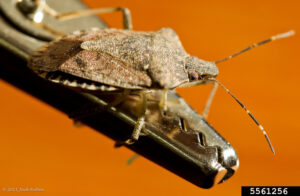
Brown marmorated stink bug adult. Photo credit: Jack Rabin, Rutgers NJ Agric. Expt. Station, Bugwood.org.
This invasive insect has a shield shaped body that is brown and marbled in appearance, with brown and white markings along the abdomen. As adults they are about 1.5 centimetres long. They do not bite, but will emit an unpleasant odour when crushed. Not all stink bugs are invasive in BC, and the brown marmorated stink bug has several look a like native species. The main distinguishing feature of the brown marmorated stink bug is the two white bands on their antennae.
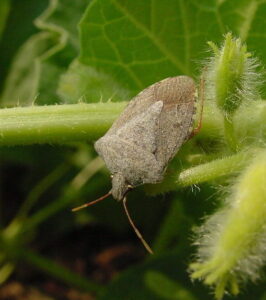

The brown marmorated stink bug looks similar to these two native species, the brown stink bug (left, photo credit: Gerald Holmes, Strawberry Center, Cal Poly San Luis Obispo, Bugwood.org) and the western conifer seed bug (right, photo credit: Mohammed El Damir, Bugwood.org). The brown stink bug does not have white bands on its antennae, and the western conifer seed bug has a more narrow body shape and no white antennae bands.
Eggs of this insect are white or light green, shaped like a sphere, and are about 1.5 millimetres in length. Brown marmorated stink bug nymphs are roughly 2-12 millimetres in length, and lack developed wings. When in this life stage, they range in colour from orange/red, to black with dark red markings.
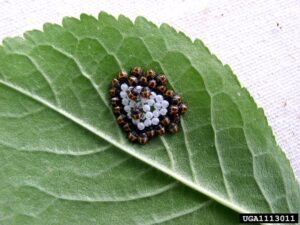
Newly hatched eggs. Photo credit: Gary Bernon, USDA APHIS, Bugwood.org.
Life Cycle
Adult brown marmorated stink bugs overwinter indoors or warm sheltered places. They emerge in the spring, between mid April to early June. Females feed for two weeks before they mate. Throughout the summer, females can lay up to 400 eggs. If the weather is warm enough, there can be two generations of bugs in a year. Eggs are laid on the host plants, on the underside of leaves, in a group of about 25. The insects develop through several nymph stages, each lasting about one week, depending on the temperature of their area. The bugs will reach maturity in roughly five weeks. They then feed in the fall to prepare for their winter of hiding, and then emerge in the spring to repeat the cycle.
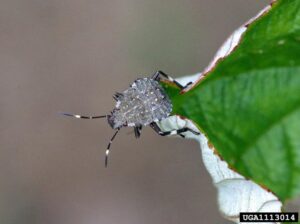
Nymph stage. Photo credit: Gary Bernon, USDA APHIS, Bugwood.org.
Ecology
These insects feed on over 100 different species of plants. This wide ranging diet has allowed them to spread far across North America. Brown marmorated stink bugs feed on the juice of fruit from trees, bushes, vegetables, and ornamental plants. In BC, these insects have feasted on wild chokecherry, berries, apples, ornamental plants, and vegetables. The bugs will find shelter over winter indoors in buildings or protected areas such as woodpiles.
Introduction and Spread
The brown marmorated stink bug is native to Asia, and was unintentionally introduced to the United States in the 1990s. This invasive insect has been detected and/or intercepted in 46 states and 5 provinces (Ontario, Quebec, British Columbia, Alberta, and PEI). It was first detected in Pennsylvania in 2001, and has since spread to the majority of North America. The brown marmorated stink bug was first detected in BC in 2015, where it was introduced via shipping containers or by hitchhiking on vehicles coming from infested areas. These insects are easily transported through vehicles, equipment, cargo containers, and packing material as they over winter in protected areas such as these.
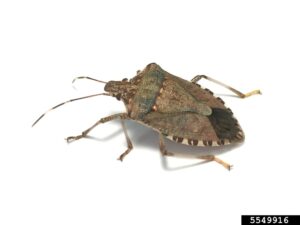
Photo credit: Kristie Graham, USDA ARS, Bugwood.org.
Impacts
This insect has a major impact on the agricultural industry, as it feeds on and destroys fruit and vegetable crops in both the nymph and adult stage. Infested fruit will be deformed, discoloured, shrivelled, and there will be an increased sap flow and discoloured bark. These insects are extremely destructive to fruit trees and cause about 37 million dollars in damage to the apple industry in the mid Atlantic states every year. This causes economical challenges for farmers and the industry as a whole. Brown marmorated stink bugs are also a nuisance to people in their homes, causing annoyance in urban areas.

Brown marmorated stink bugs attacking a peach. Photo credit: Gary Bernon, USDA APHIS, Bugwood.org.
What Can We Do?

To help prevent the spread of this invasive insect, report sightings to CSISS on our website, to the Province with their online form or on the Report Invasive mobile app. Remember to Play Clean Go, and clean off your gear, equipment, and vehicle before heading somewhere new. You can prevent invasive and native stink bugs from entering your home by sealing off entry points. If the insects are present in your home, you can sweep them up by hand or a vacuum. Biocontrol for this insect is in the development process in BC, as there are several insects that eat the eggs of the brown marmorated stink bug, such as ladybugs, spiders, and lacewings.
Literature and Resources:
- https://www.youtube.com/watch?v=uDAmG8lm2U4&t=2s – CSISS invasive insect webinar
- https://bcinvasives.ca/wp-content/uploads/2021/09/Brown_Marmorated_Stink_Bug_Factsheet_October2022.pdf
- https://www.invasivespeciescentre.ca/invasive-species/meet-the-species/invasive-insects/brown-marmorated-stink-bug/#:~:text=Range%20expansion%20of%20the%20invasive,fruit%20and%20vegetable%20crops%20worldwide.